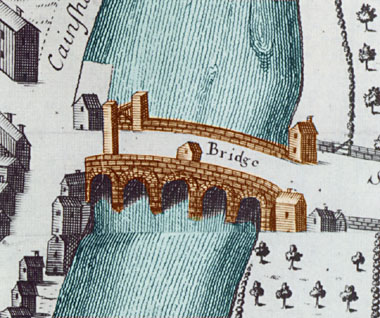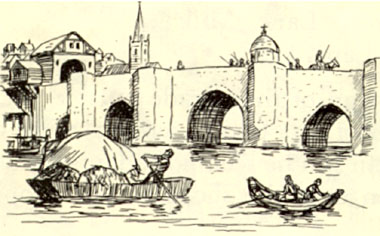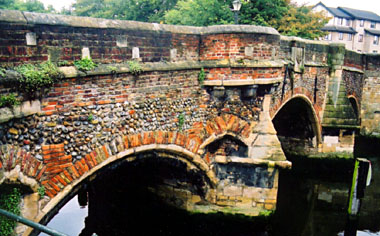
Southgate Street led out of the walled city
of Bath, and when it reached the Avon crossed over by this bridge, shown
in Gilmore's map of 1694.
Bath's bridge may have been constructed by John of Tours, Bishop of Wells from 1088, who was very active in improving the city. More likely, however, it supplemented or superseded a ford at some point in the later 12th century. Certainly it was in existence by the early 13th century; a Nigel pontarius (bridgekeeper) owned land in Southgate prior to 1230. If we can trust the accuracy of the depiction, the semi-circular arches are also suggestive of an early date, whereas the more pointed arches of the depiction below represent a slightly later technique, which enabled the span of arches to vary. The Bath bridge changed little up until 1755, when it was replaced. It has been estimated as around 20-25 ft. wide and 100 ft. long [Peter Davenport, Medieval Bath Uncovered, Stroud: Tempus, 2002, 133].
Gilmore's depiction of Bath's bridge, above, and the artist's generalized depiction of an urban bridge below, both show some fairly typical features of medieval bridges. Some had a small chapel installed, where prayers could be said for travellers and the latter in turn could give alms which might be put towards bridge maintenance. That on the Bath bridge was dedicated to St. Lawrence. Other examples include the Foss and Ouse Bridges at York, and the Hethbeth bridge at Nottingham.
As entrances into an urban area, bridges were also often furnished with gateways, for purposes of defence and toll collection. In the case of Bath's bridge, the remains of this can be seen on the left (south) side, although better depicted on Jones' map of 1572; the city itself lay to the north.

Artist's impression (20th century) of a
city bridge in the Middle Ages.
Drawing by J.C.B. Knight
The depiction above also shows another feature of some medieval bridges. The need to build large piers to support each arch led them extending out beyond the width of the narrow roadway across the bridge. At the top of those pier extensions it was possible to create refuge areas for pedestrians, so that they could get out of the way of any carts crossing. Another example can be seen on Bishop's Bridge at Norwich, below, although this example may be a post-medieval addition.

Bishop's Bridge
Photo © S. Alsford